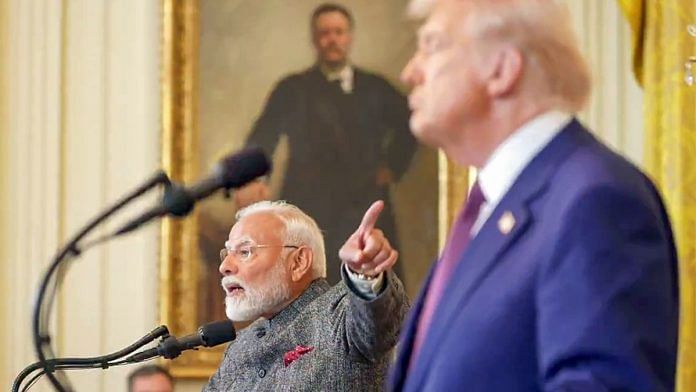New Delhi: The US Department of Homeland Security Monday issued a notice outlining its plan to implement the additional 25 percent tariffs announced by President Donald Trump on 6 August on India due to its continued purchase of Russian oil.
“Products of India, except those set forth in section 3 of Executive Order 14329, that are entered for consumption, or withdrawn from the warehouse for consumption, on or after 12:01 am eastern daylight time on August 27, 2025, will be subject to the additional ad valorem rate of duty provided for in new HTSUS heading 9903.01.84,” the notice read.
Ties between India and the US have hit a rough patch in recent weeks with Trump taking aim at New Delhi’s continued purchase of Russian crude. By announcing the additional ‘penalty’ tariffs of 25 percent, Trump took the effective tariff rate to 50 percent on Indian exports worth almost $60 billion. This is amongst some of the highest tariff rates for any American trading partner.
Mobile phones and pharmaceuticals are currently exempted from the tariffs, which are among India’s largest exports to the US. In 2024-2025, India exported roughly $86 billion worth of goods to the US, making the American market the largest for Indian exports.
Trump has publicly said that he hopes to pressurise Russian President Vladimir Putin to end the war with Ukraine through these penalty tariffs applied on India. His administration, including White House aide Peter Navarro and Treasury Secretary Scott Bessent, have in recent weeks accused New Delhi of profiting from cheap Russian oil at the cost of Ukrainian lives.
Navarro, the Counsellor to the President focusing on trade launched multiple broadsides against India last week, including through an opinion piece in Financial Times. He outlined that India has been able to create a refined petroleum export market worth roughly $67 billion in the last financial year due to the availability of cheap Russian crude.
In 2022, months after the current phase of Russia-Ukraine war began, the member-states of the G7 imposed a price cap mechanism on Russian oil, ensuring that it would sell below $60 a barrel, in an attempt to impact Moscow’s revenues.
The former American envoy to India Eric Garcetti acknowledged that the price cap was designed keeping India in mind, allowing New Delhi to purchase Russian crude, and thereby keeping the global energy markets stable.
The latest invectives emanating from the US has left External Affairs Minister S. Jaishankar “perplexed”. He pointed out that the US encouraged the purchase of Russian crude before shifting its position under Trump.
The American president has also been increasingly frustrated by the stalled negotiations for a trade deal with India. The two sides began talks for a bilateral trade deal in February, following Modi’s visit to Washington. However, efforts to reach a mini-deal to stave off the worst of Trump’s tariff threats fell through due to the US’ demands for more access to India’s agriculture and dairying sectors—red-lines for New Delhi.
The next round of trade talks, which was scheduled to begin on 25 August, has been postponed. However, Jaishankar, in recent comments to the media, noted that there has been no official cancellation of the talks.
Trump Friday also announced his ambassador pick for New Delhi—38-year old Sergio Gor. A Trump loyalist and his current personnel chief, Gor will also be handling the role of a Special Envoy for South Asian and Central Asian affairs after being confirmed by the US Senate.
Amidst these difficulties in ties with the US, Prime Minister Narendra Modi is set to travel to China on 31 August till 1 September for the Shanghai Cooperation Organisation Summit (SCO), as the thaw between New Delhi and Beijing continues to move forward.
(Edited by Mannat Chugh)
Also Read: India ‘needs to defend its interests’, no pressure from Kyiv over Russian oil purchase—Ukraine envoy







India used to kill Indians with socialism, now America wants to kill Indians with socialism.